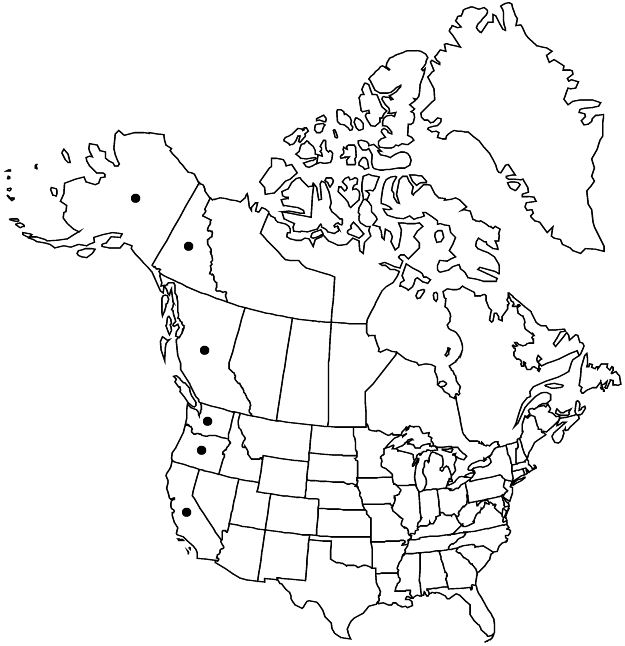Viola langsdorffii
in A. P. de Candolle and A. L. P. P. de Candolle, Prodr. 1: 296. 1824.
Plants perennial, caulescent, not stoloniferous, 2–30 cm. Stems 1–3, ascending to erect, usually glabrous, from shallow, fleshy rhizome. Leaves basal and cauline; basal: 2–3; stipules broadly ovate to deltate or long-lanceolate, margins often glandular (glands sessile or stalked), apex acute; petiole 0.8–21 cm, glabrous or sparsely pubescent; blade ovate to reniform, 0.9–5.8 × 1–6 cm, base cordate to ± truncate, margins crenate to crenate-serrulate, usually eciliate, apex rounded or acute to usually obtuse, surfaces glabrous or sparsely pubescent on adaxial veins, seldom on abaxial veins; cauline similar to basal except: stipules broadly ovate to lanceolate-oblong or deltate, apex acute to acuminate; petiole 2.2–12.1 cm; blade 1.9–4.2 × 1.8–5.9 cm. Peduncles 2.2–20.7 cm, glabrous or sparsely pubescent. Flowers: sepals lanceolate to ovate, margins eciliate, auricles 0.5–1.5 mm; petals light to deep violet on both surfaces, lower 3 white basally and light to deep violet-veined, lateral 2 bearded, lowest 12–24 mm, spur white to violet, gibbous to elongated, 2–5 mm, usually less than 1/2 lowest petal, tip straight; style head usually beardless, sometimes bearded; cleistogamous flowers axillary. Capsules ovoid to oblong, 7.5–13 mm, glabrous. Seeds dark olive to ± black, 2.5–2.8 mm. 2n = 12.
Phenology: Flowering Apr–Aug.
Habitat: Swamps, bogs, fens, wet meadows, stream banks, rocky slopes, usually near coast
Elevation: 0–1500 m
Distribution

B.C., Yukon, Alaska, Calif., Oreg., Wash., Asia.
Discussion
Viola simulata and V. superba are closely related to V. langsdorffii (L. Abrams and R. S. Ferris 1923–1960, vol. 3). They were treated by C. L. Hitchcock et al. (1955–1969, vol. 3) as synonymous with V. langsdorffii pending further study.
E. Brainerd (1921) stated that Viola langsdorffii presents an interesting transition between the caulescent and acaulescent violets. Plants of the species are reported from Winchester Grade in Idaho (Gail s.n., 1931, ID); verification is needed. Viola langsdorffii is reported to have fleshy rhizomes. Plants in Del Norte County, California, have fleshy rhizomes near the soil surface, but these are connected to deeper, subligneous rhizomes.
The style in some populations of Viola langsdorffii is reported to be sometimes bearded (G. W. Douglas et al. 1998–2002, vol. 5; W. J. Cody 2000). Illustrations in V. B. Baird (1942; location of plant unknown) and M. S. Baker (1936; a plant from Alaska) show a beardless style; L. Abrams and R. S. Ferris (1923–1960, vol. 3) and C. L. Hitchcock et al. (1955–1969, vol. 3) reported that the style head was beardless. Styles are beardless in plants occurring in Del Norte County, California.
Selected References
None.